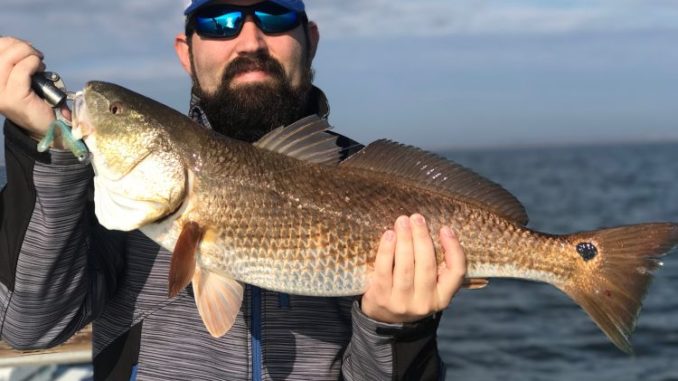
Speedy approach trumps stealth, angler says
When you’re working a flock of birds and targeting speckled trout, everyone pretty much knows the basic ground rules: Put the wind at your back. Use your trolling motor and approach quietly from a distance. Don’t spook them, and make long casts along the outer edges of the school.
Those rules change drastically, however, if you’re targeting redfish under birds in Lake Pontchartrain.
Schools of marauding reds devouring white shrimp move lightning fast, so Chas Champagne, creator of the Matrix Shad line of soft plastic lures, takes much more of an “in your face” approach when trying to hook up with Pontchartrain reds under a flock of birds.
“I’ll come up to it on plane and as I get closer, I do like a real fast idle and I’m just sitting there. Whoever is with me, I have them ready to cast. Everybody has their rod and reel in their hand, and as soon as I see a bird swoop down, I’ll punch it right to within casting distance from where that bird swooped down and I’ll throw it in neutral — I won’t even kill it,” Champagne said. “We usually use ½-ounce jigheads so we can throw it a country mile, and you want to be able to throw it in an area about the size of a kitchen. That’s about the radius you have of where that bird swooped down. It’s not as small as a hula hoop, so you have some margin for error. But if you make that cast, everybody typically hooks up.”
But time is of the essence — that’s why Champagne doesn’t even bother to shut down his motor.
“When that bird swoops down, you have about 20 seconds max to make sure you get as many lures into that kitchen as you can, because if you just blink, by the time you look up, the next swoop down will be 50 yards from you,” he said. “You blink again, and then you see a bird swoop down 300 yards from you.”
You can use a popping cork, but Champagne typically keeps things simple with a Matrix or Vortex Shad on that heavy jighead.
“I use a plain jighead so I can have more pinpoint accuracy and further casting distance,” he said.
And unlike with specks, Champagne said in his experience the sound of the motor doesn’t seem to affect the bite.
“You have to get in there. That’s so much more important than being stealthy,” he said. “Even if it does spook them a little bit, it’s better than trying to come in quiet because you’ll never keep up with them. You have to get right in there — they’re just moving too fast.”
Champagne emphasized he wasn’t just blind casting into the school — he was targeting a specific spot where he saw a bird dive. Seagulls are the best indicator for reds, he said.
“If you just see birds hovering, you’re not going to catch anything. You have to see where he swoops down and grabs that shrimp,” he explained. “When that bird swoops, there are probably five or 10 reds running at that shrimp — so you have to put it right there, and you’ve got about 20 seconds to do it.”
Champagne said birds working over schools of reds happen more often near daylight in Lake Pontchartrain, and a falling tide is better. Some common spots where schools of redfish roam include in front of Lakeshore Estates near where the Rigolets meets the lake, Salt Bayou, the Hospital Wall and in front of Irish Bayou.
“White shrimp can stay in the estuary all the way to March,” he said. “It just depends how cold it gets.”

